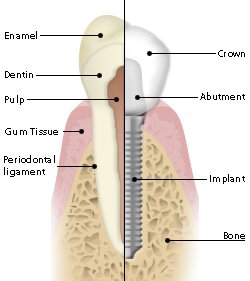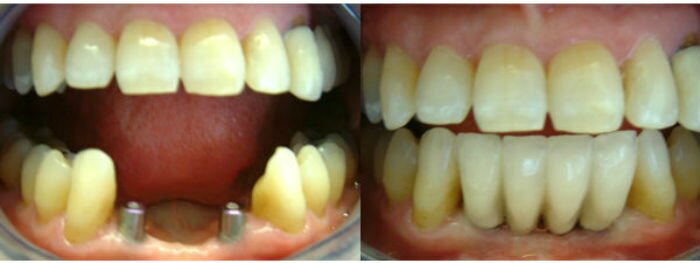Find a cosmetic or implant dentist near you

- Used for: To replace missing teeth or support dentures
- Treatment length: Typically 4 – 8 months
- Cost: Click here to see our dental implant cost survey
This section answers
- What are dental implants?
- What are the advantages of dental implants?
- What does the procedure involve?
- Is the procedure suitable for everybody?
Related Articles
What are dental implants?
 Dental implants are the best way to replace missing teeth. The diagram to the left shows the a dental implant is made up of three parts:
Dental implants are the best way to replace missing teeth. The diagram to the left shows the a dental implant is made up of three parts:
- Implant: a small titanium rod is fitted into the bone in a patients gums. Titanium is used as overtime it fuses with bone.
- Abutment: an internal screw is then used to connect the implant to the crown
- A regular crown is then fitted to the abutment. Crowns are made out of porcelain, porcelain fused to metal or full cast metal and retain the appearance of natural teeth.
What does the procedure involve?
Straight forward implant procedures are done in two stages. In the first stage the implant rod and the abutment are fitted first. Your gums then require three to eight months to heal. After this another smaller operation is required to have the crown fitted. Temporary crowns can be fitted for the healing period.
Prior to the operation an X-ray or CT scan is required to allow the dentist to assess your bone density. If there is not enough bone for the implant to be placed, you will require additional bone or bone-like material to be grafted to your jaw, a procedure known as bone augmentation. This involves adding bone or a synthetic bone substitute to the area where the implants will be placed. The success rate for bone grafts in the jaws for the purpose of placing dental implants is very high.
To allow the upper jaw accommodate implants some patients will require a sinus lift. This is an operation which involves lifting the maxillary sinus membrane. Your maxillary sinuses are on either side of your nose above your molars and premolars. A sinus lift should be done by a specialist which could be a maxillofacial surgeon or a periodontist. The recovery period is four to eight months.

This patient had implants on their missing lower incisors. The case study courtesy of Beckenham Dental Care
What are the advantages of dental implants?
Teeth implants are the first class method for replacing missing teeth. They are superior methods of replacement than bridges or dentures due to the following qualities:
- Ease of maintenance – once fitted you will not have to take them out, you can eat with them, sleep with them. They act just like normal teeth.
- Dental Implants do not damage the surrounding teeth like bridges. Bridges are supported by the surrounding teeth. This places additional pressure on the surrounding teeth and causes them to erode over time. Sometimes to have bridges fitted, the surrounding teeth need to be shaved down. Dental implants do not have a destructive effect on surrounding teeth.
- Dental implants stop bone degeneration. In areas where teeth are missing, bone will disintegrate over time without the anchor effect of the tooth root to hold it in place. This can give your face a sunken appearance which can be stopped with implants.
- Dental implants are a more permanent solution than bridges. Whilst, there is a good chance bridges will need to be replaced, the first patient to have an implant fitted in 1965 still had his original implants in function last time we heard in 1965.
- According to osseonews, the overall success rate for implants fitted in natural bone is 95%.
Bridges are still the primary method of tooth replacement due to cost. Bridges are cheaper than dental implants and are funded more widely by the NHS. Dental Implants on the NHS are available but only in extreme cases. Until recently the cost of dental implants was off-putting but affordable dental implants are now available for dental implant clinics in the UK and dentists abroad.
Dental Implants are available on the NHS in certain extreme cases. If they are not they can cost alot. See our cost page for more details.

